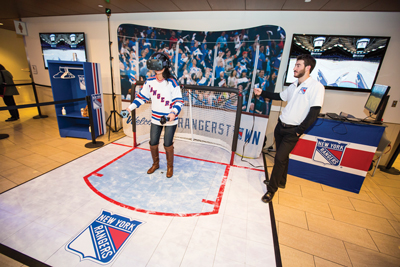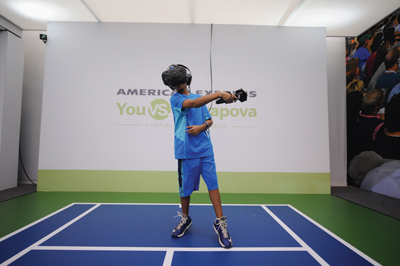It’s long been hockey lore that being a goaltender requires a particular, even odd, mindset to have pucks fired at one’s head every night. At Madison Square Garden, for every New York Rangers game, hundreds of fans line up to simulate that very feeling through virtual reality.
The club, in partnership with California-based virtual reality firm Strivr Labs Inc., recently debuted a goalie simulator on the MSG concourse. The attraction offers a two-minute goalie drill, narrated by Rangers broadcaster Sam Rosen, from a virtual vantage point of standing inside the goal crease and facing shots from oncoming skaters.
The element, in development between MSG and Strivr since last summer, has quickly proved to be a fan favorite, and offers one of the most lifelike experiences possible of being on the ice short of actually lacing up skates.
It’s also a far different experience than simply watching a live game in virtual reality, which has been an early focus
 |
Fans of the New York Rangers can see what it’s like to be an NHL goalie.
Photo by: New York Rangers |
in this white-hot space. But with the benefit of time and additional post-production efforts, virtual reality in a fan experience setting offers something truly unique in the industry. What initially has been simply donning a pair of virtual reality glasses to watch a game has become something in this context even more immersive.
“We want to use virtual reality to bring fans closer to the athletes and sports they love,” said Brian Murphy, Strivr’s managing partner, who will co-lead the company’s new fan experience division and himself is a former college baseball player. “We can help really redefine what behind-the-scenes access really means.”
The Rangers and MSG are far from alone, as several other virtual reality fan experience offerings have cropped up around the country and in numerous other sports. Strivr also has worked with the New England Patriots to create an attraction that allows fans to experience the feeling of standing on the 50-yard line at Gillette Stadium as if they were a player, and going through team facilities such as the locker room, weight room and practice fields.
Strivr’s ongoing work with the Patriots and MSG were key parts of a recent move to create a fully fledged fan experience division.
Gatorade last year also debuted a virtual reality video featuring Washington Nationals outfielder Bryce Harper, offering a simulated perspective of standing in the batter’s box, and continues to experiment with the technology.
SAP featured a virtual reality-powered quarterback challenge as part of its Super Bowl City Fan Energy Zone at Super Bowl 50. And American Express last year set up a virtual reality booth at the U.S. Open for tennis, offering a simulated experience of facing shots from Maria Sharapova, including the feeling of being on the receiving end of a serve reaching 110 mph.
Numerous other iterations are expected during the course of 2016 for what remains one of the hottest technologies in all of sports and entertainment. Murphy said Strivr has signed an undisclosed Major League Baseball team that will create for the 2016 season a virtual reality experience that will, not unlike the Harper video for Gatorade, re-create the feeling of standing in the box to face a big league fastball.
In nearly every instance, the efforts have been free to the consumer, underwritten by a corporate sponsor, and presented in the name of deepening fan ties.
“We’ve actually made investments in several VR companies. We believe this is a very interesting technology for fan engagement,” said Andrew Lustgarten, MSG executive vice president of corporate development and strategy, citing the company’s equity interests in virtual reality companies Next-VR and Jaunt, among others. “We expect this to be very impactful to the in-venue experience, and we want to be at the forefront of what’s happening in this space.”
The accelerating use of virtual reality in such fan amenity settings differs significantly from the more traditional, media-driven efforts that have dominated the early stages of the technology’s development. Many of the initial virtual reality experiments have been content driven, offering an enhanced way to watch a live game.
Given the heightened importance of the live game within the overall sports industry ecosystem, those efforts will certainly continue. But parallel to that, teams and technology firms alike are trying to find ways through virtual reality to deepen both the in-venue and non-game-day fan experience.
“This is only the beginning. We think there will be a lot of additional testing out in the market to see what fans really respond to,” Lustgarten said.
 |
American Express offered a virtual reality experience at last year’s U.S. Open for tennis.
Photo by: Getty Images |
And while the market for virtual reality-based advertising remains a work in progress for broadcast settings, particularly in live settings, brands have already been aggressive in attaching themselves to the more fan experiential and in-venue uses of the technology.
In addition to the work by American Express and Gatorade, large corporations such as Visa, Bank of America and Time Warner Cable have sponsored virtual reality projects, in many cases helping cover the hardware and software costs that can run well into the tens or hundreds of thousands of dollars depending on the particular scope of the project. The marketing additionally provides settings that cannot easily be replicated elsewhere and a new form of exclusive inventory for brands. But numerous executives involved in virtual reality said that given the newness of the entire space, a variety of other business models will likely emerge over time.
“We’re trying to create an emotional connection, and this is a great opportunity to provide a different kind of experience to the fan,” said Kenny Mitchell, Gatorade senior director of consumer engagement, upon the release of the Harper video.
The fan experience deployments of virtual reality frequently have some type of link to training solutions used by teams and players in team development scenarios. Strivr Labs, for example, began as a startup out of the Stanford University Virtual Human Interaction Lab, building products for coaching before creating the new fan experience division, and now works with more than two dozen pro and college football teams. SAP, similarly, has aided several sports entities in recent years in their player development efforts, particularly with regard to big data and analytics.
As a result, the high degrees of realism insisted upon by team operations personnel in virtual reality are now being applied to the fan-facing products.
“If it’s not real, if it’s all video game or [computer-generated image] type of stuff, it can’t be really useful as practice footage,” Murphy said. “We’re still a training company first and foremost. But there are really interesting ways we can also use virtual reality for the betterment of the fan.”





